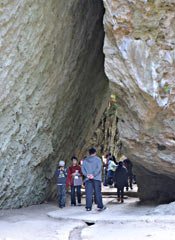Seifa Utaki the sacred prayer site to close six days a year from 2012 for preserve the environment

Sacred prayer site Seifa Utaki will be closed for six days a year from 2012. December 27, at Nanjo City.
December 28, 2011 Ryukyu Shimpo
On December 27, the Nanjo Municipal Office announced that from 2012 it will close the sacred prayer site Seifa Utaki for six days a year from May 1 to 3 and October 1 to 3 of the lunar calendar.
After being designated as a World Heritage Site in 2000, the numbers of tourists has increased every year and it is thought that about 400000 people will have visited the site by the end of 2011. However, improper behavior by visitors, such as taking photographs by clambering up an altar has been a problem. The municipal authorities have received complaints from worshippers and are also concerned about the impact on the local natural environment.
Nanjo City authorities will restrict access to the site on a trial basis to maintain the tranquility of the sacred spot in an attempt to improve the behavior of visitors and out of consideration for the preservation of the natural environment. These new regulations will apply to everyone including worshippers and officials and in order to convey the culture surrounding the lunar calendar, the municipal authorities set the dates according to that calendar, with a spokesperson saying, “In Okinawa, many annual events follow the lunar calendar.”
At a news conference, Mayor Keishun Koja said, “Seifa Utaki is special sacred prayer site not a tourist spot. We would like to encourage people to preserve it so it can be passed on to the next generation. We merely ask for cooperation and assistance.”
Eishin Futenma, president of the Association for Introducing the Cultural Properties of Chinen said, “Deciding upon the days when it will be closed indicates the City’s intention to improve the environment of the site, but it would have been better if they had set days during the summer vacation since the site gets more than 2000 visitors a day during that period.”
(English translation by T&CT, Shinako Oyakawa and Mark Ealey)
Previous Article:Wishing everyone good luck for the coming year
Dedication exercise at Shuri Castle
Next Article:Five humpback whales spotted off Zamami Island
[Similar Articles]
- Izaiho Exhibit to store memory of sacred ceremonies in Okinawa
- Locals complain of tourists trespassing to take Instagram photos on “sacred island” Kudakajima
- Shuri Castle, Seifa-Utaki, and others: 20 years since the UNESCO World Heritage List inscription
- Prayer for rain comes true in Kumejima
- Summer bonus from the sea for Ojima Islanders
 Webcam(Kokusai Street)
Webcam(Kokusai Street)


